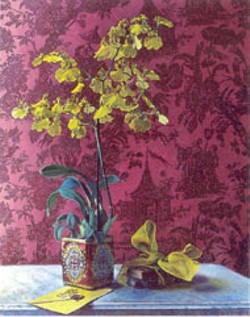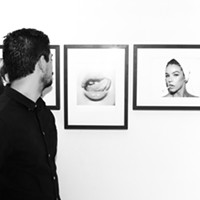The exhibit features the work of seven artists who explore interior and exterior worlds through a variety of painterly and stylistic approaches.
Jacob Cooley creates quiet, still landscapes, as in "Low Country-Twilight October." All of his paintings have an air-brush quality of perfection when you look at them directly, but shift your position and you see the nuances of the paint and the fan-brush. Compositionally, the paintings exhibit both flatness and infinite space at once. This is done through the interplay of line, color, shape and texture (or lack thereof). The water zigzags through the marshy landscape, leading our eye to a distant vista, while the monochromatic palette and even paint application subdue the image.
Paige Laughlin's work is a marked contrast to Cooley's hushed landscapes. Laughlin's painting "Untitled (golden room)" is raucous by comparison; her palette is brash and her brush is heavy to create an elegant interior teeming with light and energy. The layering of paint and color, the impasto and the scumbling, create gleaming textures in a room that overflows with the light of late afternoon.
There are no familiar archetypes, save color, in Elena Madden's highly abstract work. The three paintings on display depict dynamic, undulating ripples of color. The work isolates how light plays upon surfaces such as water and land. It reminds me of the dazzling colors to be found throughout the day as light hits various objects in the landscape, in the office ... if we pay attention and look. No hallucinogens required.
Joseph Oddo, a former artist-in-residence at the McColl Center for Visual Art, is a talented painter of landscapes, seascapes and cityscapes. His palette, earthy and direct, results in lushly painted impressions of the world. Oddo paints in the tradition of Realism -- he doesn't sugarcoat his subject. He paints the raw vitality of what he sees without commentary, while capturing the poetic found in the ordinary.
The watercolors of Richard Siegel capture nature's energy. They're not typical of most watercolors, primarily because of their enormous size. His treatment of subject is reminiscent of Neil Welliver's landscape paintings, which are as much about scale as they are about subject. Siegel's painting "October Aspen" borders on abstraction. The composition isolates a portion of trees mid-trunk to create a vivid, light-filled excerpt from nature. When looking at watercolors, it's always interesting to look at how artists incorporate the white of the paper in their work, and Siegel is no exception. Most notable in his work is the way in which he uses the white of the paper to create light, depth and movement.
The paintings by Ruth Ava Lyons and Gail Wegodsky are particularly engaging because of their quasi-narrative subject matter. Their paintings are a pleasure to consider on many levels.
Ruth Ava Lyons' paintings are otherworldly and familiar at the same time, an unusual but interesting combination that engages the viewer's imagination. The images she presents in the show are dreamy, mysterious landscapes and seascapes that beckon and invite us to reflect upon our experiences. The work, though personal to Lyons, is still accessible to us because of her use of recognizable symbols: water, moon, boat, forest, trees, and so on. These images and their meanings are accessible to us because they're familiar archetypes.
Lyon's work and her approach make me think of Carl Jung's notion of the collective unconscious. Jung was a psychologist who believed that not only is there a personal consciousness but also a collective unconscious made up of cross-cultural, universal and enduring elements of human experience. According to his theory, humans share a common, inborn unconscious life that expresses itself through archetypal images and symbols.
Gail Wegodsky is a highly skilled painter of interior still life scenes. They're painted in the tradition of 17th century Dutch memento mori paintings, which were meant to show the passage and the transitory nature of time. In her painting titled "The Letter," we see such reference to time and its passing. The painting depicts an antique occasional table in a paneled room. The table is chock-full of objects illuminated by light from a neighboring window. The objects are related to writing and "letters" -- both actual and literary. There's a letter, written and signed by the artist, that's half-open upon a decorative ceramic pedestal. There's a clock that reads 5pm, as well as a pen, an inkwell, a couple of well-placed small bound books (letters), and a velvet-lined object that appears to be an antique, portable box for writing and keeping correspondence. The light that infiltrates the room, coupled with the interplay of objects past and present, points to the nature of time ever moving toward time past, time present, time future (to borrow from T.S. Eliot).
Wegodsky's approach to her paintings is also reminiscent of an illusional painting technique called trompe l'oeil (pronounced trom-ploy, literally French for fooling the eye). This type of painting is often so effective that viewers become convinced that what they see is actually real and not painted. In her painting, it's the textures that truly trick the eye, as in the painting titled "Palladium Orchid," which features a lush interplay of color: the chartreuse/ yellow of an oncidium-type orchid and the highly patterned wallpaper in shades of burgundy. A striking palette and a striking painting.
The current show at Center for the Earth is aptly named, especially considering that it meets a definition of pleasure; that is, to provide enjoyment and/or delight. So make a point to stop by and indulge in the pleasure of looking at art.
The exhibit Pleasure Places will run through February 28 at Center of the Earth Gallery, 3204 N. Davidson Street. Call 704-375-5756 for details.
Latest in Feature
More by Amy Swisher
-
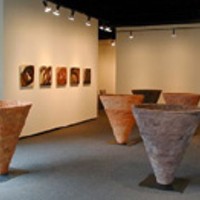
Modern ideas and mythology
Mar 19, 2003 -
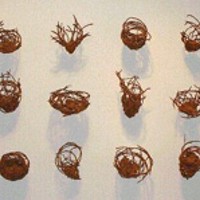
An Artful Balance
Mar 12, 2003 -
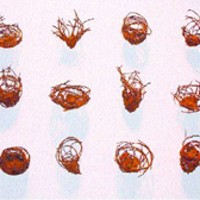
An Artful Balance
Feb 26, 2003 - More »
Calendar
-
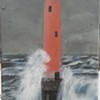
NEW WINDOW GALLERY-Pat Rhea-ACRYLIC PAINTINGS-April 05-30 2024 VALDESE, NC 28690 @ New Window Gallery/Play It Again Records
- Through April 30, 12 p.m.
-

WHISKEY TASTING: VIRGINIA HIGHLANDS WHISKY @ Elizabeth Parlour Room
-
An Evening With Phil Rosenthal Of "Somebody Feed Phil" @ Knight Theater
-
Kountry Wayne: The King Of Hearts Tour @ Ovens Auditorium
-

Trap & Paint + Karaoke @ Zodiac Bar & Grill
-
The joy and pain of comedian Oletha Cuevas 2
-
The ugly truth in Sociales: Débora Arango Arrives Today
Living in a country and a time that required women to keep their heads down and their mouths shut, this artist did neither.
-
Charlotte Symphony Teams with Punk Violinist
Flaming redhead torches Red Priest

